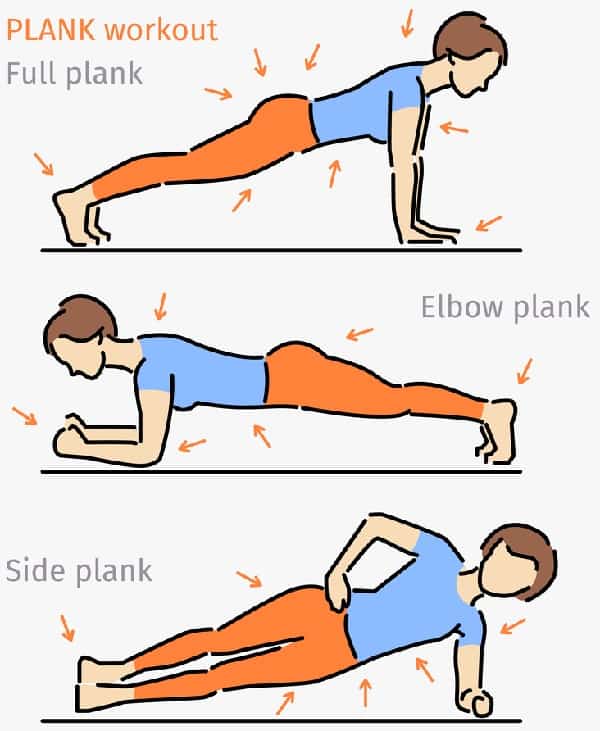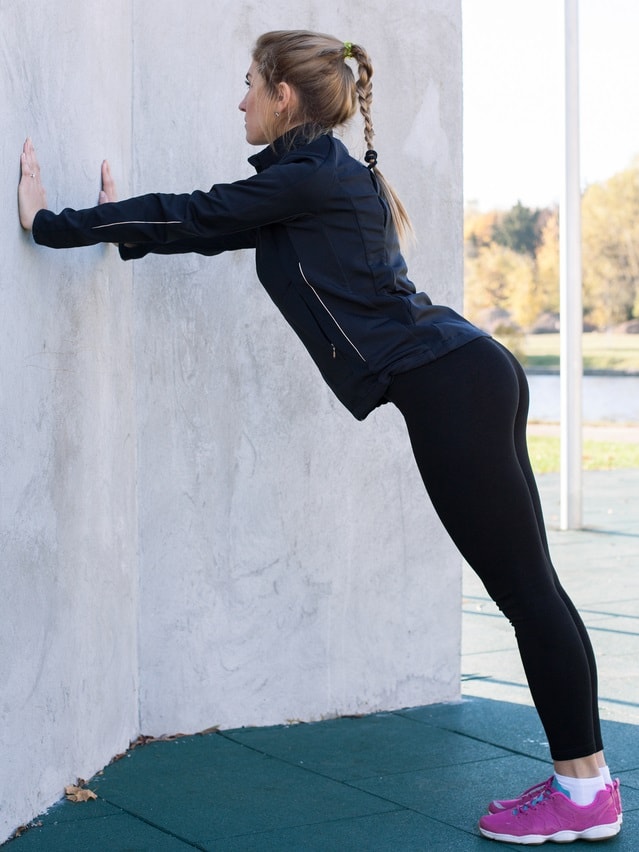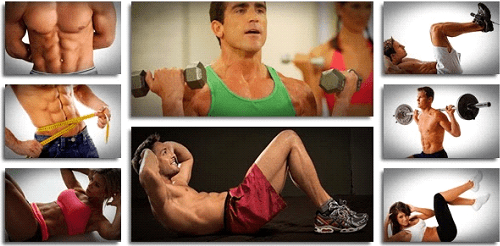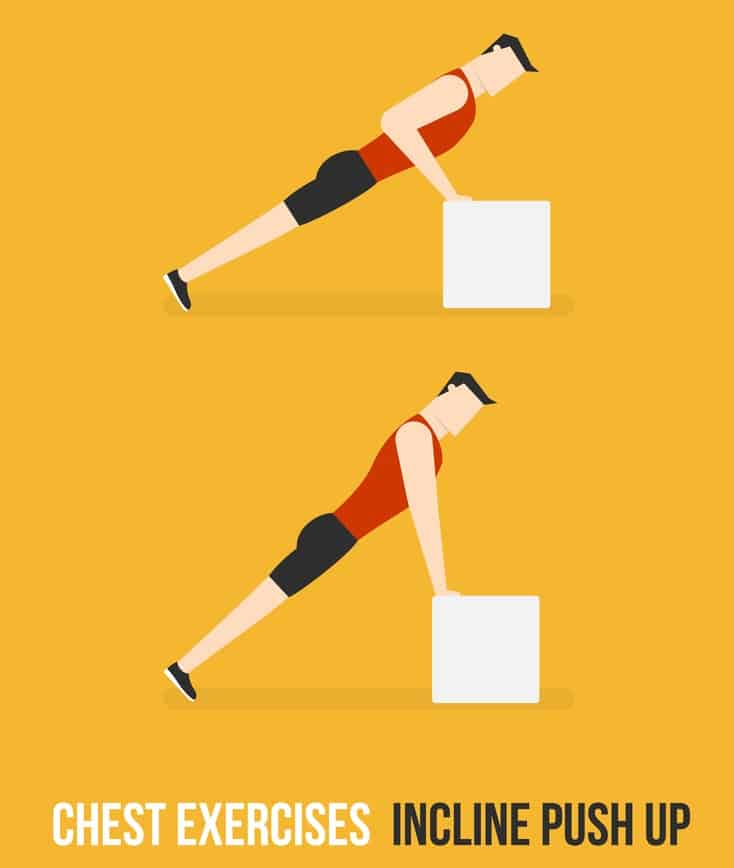If you’re just getting started with a workout plan, then you might want to skip the dumbbells and machines, and instead focus on exercises that use your body weight only.
By exercising with the weight of your body, you can even skip the gym or maintain your workout program when you’re traveling.
Beginners tend to focus on cardio or more obvious bodyweight exercises like squats, lunges, and sit-ups.
The chest is often overlooked, but strengthening these muscles has tremendous benefits. Because it’s the center of your body, it’s responsible for a lot of mobility.

Benefits of Doing Chest Exercises
You use these muscles all day long without even thinking about it. Opening doors, getting out of bed, and even washing your hair all require this muscle group. The stronger your chest, the stronger you are.
And it’s not just about strength. Having a well-developed chest enhances your physical appearance, too.
Women who frequently work out these muscles find that they get an extra lift in their bust area, preventing sagging and enhancing the shapeliness of “the girls.”
For men, it keeps “man boobs” in check, and it creates a broader and more masculine-looking upper body.
This may also come as a surprise, but by working the chest muscles, you also build strength in other parts of your body, too.
You’ll notice more tone and definition in the arms and upper back, too. That’s because most of these exercises work other parts of the body at the same time as your chest.
In this article, we’ll share our favorite chest exercises that are suitable for beginners and require no equipment other than your own body weight.
We’ll start with pushups because they’re the most fundamental, and we’ll describe some popular variations that target different areas.
There are, of course, other exercises other than pushups, so we’ll cover those as well. And finally, we’ll share the best stretches to increase mobility and help prevent injury.
Read More: How to Do Back and Triceps Workouts Properly
The Perfect Push Up
Push-ups are everyone’s go-to chest exercise.
They require zero equipment, they can be done in a seemingly infinite number of positions, and they work other muscle groups, including the arms, back, and core.
In fact, pushups are probably the single best exercise if you’re looking for an efficient workout that yields results fast.
To get the most out of a push up, it should be done in proper form. We see even advanced gym-goers get this wrong, so we’ll show you step-by-step how to do a perfect push up, even if you’re starting on your knees.

Here’s how to do the perfect push-up:
- Start on your hands and knees. Your hands should be shoulder-width apart.
- Lift your knees off the ground and extend your legs behind you. You are now in a “plank” position.
- Keeping your body straight, slowly lower your chest so it nearly touches the floor. Your elbows should be at a 90-degree angle.
- From this position, push yourself back up to neutral.
If you prefer to do pushups on your knees, then the only thing that changes is step 2.
Instead of lifting your knees off the ground, slide your hands forward so they are near your head.
Then tilt your body forward so that you are in a classic push-up position. The only exception, of course, is that your knees are still touching the ground.
Here are some tips to make sure you’re doing this exercise correctly:
- Keep your back straight. Don’t arch it. Tilt your pelvis slightly inward and squeeze your booty.
- The width of your arms isn’t all that important because your preferred placement will depend on the part of the chest you’d like to target. However, make sure that your arms form a straight line with your shoulders. They shouldn’t be too far in front of you or behind you. (There are exceptions if you’re doing an advanced variation, but the exercises covered in this article follow this rule.)
- Maintain a full range of motion. Go all the way up, and all the way down. The quality of your pushups is more important than the quantity.
- Keep your head straight. Don’t let it drop. Maintaining this position is more challenging, but it’s the right way to do the exercise.
Variations
- Wall Push Ups

This variation is ideal if you’re looking for something less intense and you also want to stay off of your knees.
They’re also great at targeting other areas than your chest, including the core, biceps, deltoids, lats, and rhomboids.
Here’s what to do:
- Stand, facing a wall, about two to three feet from it. Act as if the wall is the floor and press your palms on the wall in your classic pushup position, shoulder-width apart.
- Bend your arms at the elbow and lower yourself down toward the wall. As you breathe, this part of the exercise should be done on the inhale.
- Exhale and push yourself back to starting position.
- Do three sets of ten to fifteen reps.
You can make this exercise as easy or as challenging as you’d like, depending on the angle you place your body and the width of your hands.
We like this particular variation because it can be done during an outdoor workout like a hike or run.
- Wide Push Ups
This exercise is just like your standard push up, but you do it with your hands wider apart. The effect is more concentrated effort in the chest area, which is exactly what you’re looking for.
- Narrow Push Ups
Bring your hands closer together for this variation.
A popular position is to put your hands in a diamond or triangle position. We’ll warn you in advance that this is a tough one and you’ll feel it profoundly in your triceps. You may need to start on your knees for this exercise.
- Decline Push Ups
Instead of pushing yourself up from a flat floor, you’ll be lowering yourself down and pushing up from an angle.
To do this exercise, rest the tops of your feet on a surface like an inflatable exercise ball or a bench. Everything is the same as a regular push up, but you’ll feel a greater amount of pressure in your chest.
- Incline Push Ups
This exercise is the opposite of decline. Instead of having your feet elevated, your upper body is now propped up. You can do these pushups on a block, bench or any surface that’s one to three feet off the ground.
Again, the basic mechanics are exactly the same.
The only thing that’s different is which part of the muscles feel the most burn. When you were at a decline, you would have felt more work happening in the upper chest and shoulder (deltoid) area.
The incline variation will work your lower chest and back more.
- Medicine Ball Push Ups
These are more challenging, so make sure you master the other variations before trying this one.
Again, the movements are all the same as the other push-ups, except you place each of your hands on a medicine ball.
It’s more difficult because you no longer have a stable surface for your hands, so you have to balance yourself. The act of balancing causes your muscles to shake and seek stability, which builds them faster.
- Isometric Chest Exercise
An isometric exercise means that you’re holding a position without moving.
While they may look easy, they can be an intense mental and physical challenge. Isometric training burns fat, builds muscle, and also helps to stabilize muscle groups and surrounding areas.
To do this particular exercise, follow these four easy steps:
- Stand up straight with your feet shoulder-width apart.
- Interlock your fingers and hold your hands in front of your chest, similar to a prayer position.
- Press as hard as you can and hold for 10 to 30 seconds.
- Repeat two more times.
You’ll feel this exercise in your outer chest, right below your armpits and your shoulders, too.
You can target different parts of your chest and muscle groups by raising or lowering your arms, so we encourage you to experiment, and find spots to focus on that you didn’t hit with all of those pushups earlier!
- Svend Press
This exercise is often done with weights, but if you’re just starting out or you have an injury, you’ll still get plenty of benefits without a weighted plate.
Start in the same position as your isometric exercise. You can clasp your hands together in the same way as well. Then extend your arms straight out in front of you. Make sure to tense your muscles as you’re doing this movement, so you feel some tension.
- Dips
Dips are best done on bars that are parallel. But if you’re not a gym, you can get creative with a couple of household items.
If you have two chairs that are identical in size, shape, and height, these will suffice. Make sure the chairs are on a carpet or rug, so they won’t slide out from under you and cause an injury.
Place the chairs with the backs facing each other but with enough space between them that you can stand in the center.
Now comes the fun part:
- Stand between the chairs and place a palm down on the top of each chair.
- Lift your feet off the ground and let your feet dangle behind you.
- Slowly lower yourself down, so your elbows are at a 90-degree angle.
- Push yourself back up to a neutral position.
- Aim for three sets of ten reps, but realize you may need to build up to this number.
Don’t Forget to Stretch
Stretching helps to prevent injury while also preserving and enhancing your range of motion. Here are two chest stretches we recommend you do before or after a workout:
- Basic Chest Stretch
Stand with your feet hip-width apart. Raise your arms to your chest, palms facing in.
Then spread your arms as far apart as you can. You’ll feel your chest open up as well as some relief behind your shoulder blades.
- Behind the Back Elbow Stretch
Stand up straight and place your hands at the base of the lower back.
Try to squeeze your elbows together. Again, in addition to this position working as a helpful chest stretch, you’ll also feel it in your shoulders.

Products Guides:
https://www.slimtree.com/dbal-max-reviews/
https://www.slimtree.com/d-anabol-25-review/
https://www.slimtree.com/legal-steroids/
https://www.slimtree.com/crazybulk-dbal/
https://www.slimtree.com/crazybulk-bulking-stack-reviews/
https://www.slimtree.com/mass-stack-review/
https://www.slimtree.com/crazy-cutting-stack-pack/
https://www.slimtree.com/crazy-bulk-guide-reviews/
https://www.slimtree.com/crazy-mass-reviews/
https://www.slimtree.com/cutting-stack/
https://www.slimtree.com/anabolics-com/
https://www.slimtree.com/best-mass-gainer-vs-best-weight-gainer-supplements/
